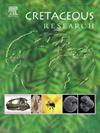Turtles of the Aguja and Javelina formations, Upper Cretaceous (Campanian – Maastrichtian), west Texas
IF 1.7
3区 地球科学
Q1 GEOLOGY
引用次数: 0
Abstract
Freshwater turtles of the Aguja and Javelina formations include Basilemys, Adocus, Compsemys, and Aspideretoides which are widely distributed and have long ranges throughout Campanian-Maastrichtian strata in the Western Interior of North America. Several species with restricted ranges are however documented for the first time, including Neurankylus baueri, Denazinemys nodosa, and Thescelus rapiens. Fragmentary specimens also record an unidentified baenid, likely kinosternoids and chelydrids, and three trionychids other than cf. Aspideretoides spp. Specimens attributed to Neurankylus baueri are among the largest known. A Neurankylus specimen from the Javelina Formation likely represents a distinct unnamed late Maastrichtian species. Thescelus rapiens is reported for the first time outside of New Mexico. Denazinemys occurs throughout the Upper Cretaceous section, with the most complete specimens attributed to D. nodosa. The Denazinemys lineage was restricted to the southern part of the Western Interior throughout its history, and survived into late Maastrichtian time only in Texas. The Campanian turtle fauna is allied with those of northern Mexico, New Mexico, and Utah in the presence of bothremydids along with the baenids N. baueri, D. nodosa, and T. rapiens; together these comprise a distinct ‘southern’ Campanian assemblage. Maastrichtian turtles comprise a lower diversity fauna of mostly cosmopolitan taxa, as is also the case in correlative strata in New Mexico and Utah. This may reflect drier inland habitats represented in these ‘southern’ deposits, compared to coastal habitats that hosted a diverse endemic turtle fauna at northern sites bordering the remnant interior seaway at the end of Cretaceous time.
德克萨斯州西部上白垩纪(坎帕尼亚-马斯特里赫特)的Aguja和Javelina地层的海龟
Aguja和Javelina地层的淡水龟包括Basilemys、Adocus、Compsemys和Aspideretoides,它们广泛分布在北美西部内陆的坎帕尼亚-马斯垂克地层中,分布范围很广。然而,一些分布范围有限的物种是第一次被记录下来,包括baueri Neurankylus, Denazinemys nodosa和Thescelus rapiens。碎片标本还记录了一种身份不明的贝类,可能是kinosternoids和chelydrids,以及除了cf. Aspideretoides spp之外的三爪目。属于baueri Neurankylus的标本是已知最大的标本之一。来自Javelina组的神经龙标本可能代表了一个独特的未命名的马斯特里赫特晚期物种。据报道,这是第一次在新墨西哥州以外的地方发现这种植物。Denazinemys分布于上白垩纪剖面,最完整的标本归属于D. nodosa。Denazinemys的血统在整个历史上被限制在西部内陆的南部,并且只在德克萨斯州幸存到马斯特里赫特时代晚期。坎帕尼亚龟的动物群与墨西哥北部、新墨西哥和犹他州的龟群相似,有botherremydids以及baenids N. baueri、d.n odosa和t.r iens;这些组成了一个独特的“南部”坎帕尼亚组合。马斯特里赫特龟组成的动物群多样性较低,主要是世界性的分类群,在新墨西哥州和犹他州的相关地层也是如此。这可能反映了这些“南部”沉积物中较为干燥的内陆栖息地,而在白垩纪末期,与残留的内陆海道接壤的北部地区,沿海栖息地拥有多种特有的海龟动物群。
本文章由计算机程序翻译,如有差异,请以英文原文为准。
求助全文
约1分钟内获得全文
求助全文
来源期刊

Cretaceous Research
地学-地质学
CiteScore
4.10
自引率
19.00%
发文量
235
审稿时长
12 weeks
期刊介绍:
Cretaceous Research provides a forum for the rapid publication of research on all aspects of the Cretaceous Period, including its boundaries with the Jurassic and Palaeogene. Authoritative papers reporting detailed investigations of Cretaceous stratigraphy and palaeontology, studies of regional geology, and reviews of recently published books are complemented by short communications of significant new findings.
Papers submitted to Cretaceous Research should place the research in a broad context, with emphasis placed towards our better understanding of the Cretaceous, that are therefore of interest to the diverse, international readership of the journal. Full length papers that focus solely on a local theme or area will not be accepted for publication; authors of short communications are encouraged to discuss how their findings are of relevance to the Cretaceous on a broad scale.
Research Areas include:
• Regional geology
• Stratigraphy and palaeontology
• Palaeobiology
• Palaeobiogeography
• Palaeoceanography
• Palaeoclimatology
• Evolutionary Palaeoecology
• Geochronology
• Global events.
 求助内容:
求助内容: 应助结果提醒方式:
应助结果提醒方式:


